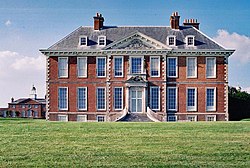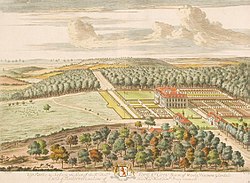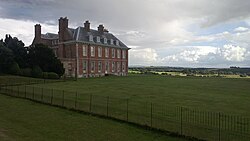Difference between revisions of "Uppark"
(Created page with "{{Infobox NT |name=Uppark |county=Sussex |picture=Uppark-Sfront-01.jpg |picture caption=The south front of Upparkl |os grid ref=SU77981758 |latitude=50.9530556 |longitude=-0.8...") |
(No difference)
|
Latest revision as of 14:03, 24 March 2021
| Uppark | |
|
National Trust | |
|---|---|
 The south front of Upparkl | |
| Grid reference: | SU77981758 |
| Location: | 50°57’11"N, 0°53’30"W |
| Built c 1690 | |
| Information | |
Uppark is a 17th-century country house in South Harting, in Sussex. Built for the 1st Earl of Tankerville in the reign of King William III, today the house and its estate are in the care of the National Trust
The house is a Grade I listed building[1]
History
The house is set high on the South Downs. It was built for Ford Grey (1655—1701), the first Earl of Tankerville, around 1690, and the architect is believed to have been William Talman.
The estate was sold in 1747 to Sir Matthew Fetherstonhaugh and his wife Sarah. Matthew and Sarah redecorated the house extensively from 1750 to 1760 and introduced most of the existing collection of household items displayed today, much of it collected on their Grand Tour of 1749 to 1751. Their only son, Sir Henry Fetherstonhaugh, added to the collection and commissioned Humphry Repton to add a new pillared portico, dairy and landscaped garden. In the 19th century stables and kitchens were added as separate buildings, connected to the main building by tunnels.
Sir Harry married, at the age of 71, the estate's dairymaid, 21-year-old Mary Ann Bullock, and he left Uppark to her on his death in 1846. She in turn, after considerably upgrading the property, left it to her sister Frances on her own death in 1874. Frances Bullock, under her adopted name of 'Miss Fetherstonhaugh', was determined to fulfil the trust her sister had passed on. She chose her two friends, Colonel Turnour and Admiral Meade, to be her heirs in succession. Both were selected as second sons who could, therefore, adopt her name, which both went on to do.[2] Admiral Meade's wife, Margaret, became the next mistress of Uppark in 1931. She continued caring for the house and contents as the Bullock sisters had done.
After the Second World War, Admiral Meade-Fetherstonhaugh and his son, Richard, entered into negotiations with the National Trust, the outcome being that Uppark passed to the Trust in 1954. The house is open to the public, except for private apartments leased from the Trust that are still used as a home.
Influence on H. G. Wells
The 20 year-old H. G. Wells spent the winter of 1887/88 convalescing at Uppark, where his mother, Sarah, was housekeeper between 1880 and 1893.[3] She had previously been employed there between 1850 and 1855, as housemaid to Lady Fetherstonhaugh's sister, and Wells had paid many visits to her during his boyhood. Wells' father, Joseph, a gardener, was employed at Uppark in 1851 and he and Sarah married in 1853.[4]
Later biographers have claimed that the house and its social hierarchy inspired in Wells the meritocratic, liberal and later socialist views.[5] These impressions were reflected in his later work: for example, the contrast between the sunny and carefree world of the Eloi and the dark caves of the Morlocks in The Time Machine.[6] As significant was Wells' discovery of a telescope in the house's attic, which gave the future author of The War of the Worlds his first opportunity to examine the night sky in detail.[7]
Fire
On 30 August 1989 the building was devastated by a fire caused by a workman's blowtorch whilst repairing lead flashing on the roof, just two days before the work was due to be completed.[8] The fire broke out during opening hours. Many works of art and pieces of furniture were carried out of the burning building by members of the Meade-Fetherstonehaugh family, National Trust staff and members of the public. Although the garret and first floors collapsed onto the lower floors and the garret and first floor contents were lost completely, the floors largely fell clear of the ground floor walls and much of the panelling and decoration survived.
Much of the contents of the ground floor was crushed but not burned; metalwork was able to be straightened and cleaned, crystal chandeliers were able to be reassembled, and even the elaborate tassels on the chandelier ropes were able to be conserved. The decision to restore the house came after it was determined that restoration would be a cheaper insurance settlement than complete payout for a total loss.
Most of the pictures and furniture in the house were saved. The building has since been completely restored with many lost crafts relearned in the restoration process, and it reopened its doors in 1995.[9]
Outside links
| ("Wikimedia Commons" has material about Uppark) |
References
- ↑ National Heritage List 1025979: Uppark
- ↑ Wyndham, Richard (1940). Last Look Round. London: Batsford.
- ↑ Nikolaus Pevsner: The Buildings of England: Sussex, 1965 Penguin Books ISBN 978-0-300-09677-4pages 358–60
- ↑ Wells, Herbert G. (1934). H.G. Wells: Experiment in Autobiography. New York: J. B. Lippincott Co.. https://www.fadedpage.com/showbook.php?pid=20100511.
- ↑ Michael Sherborne, H.G. Wells: Another Kind of Life (London: 2010), pp. 40-42.
- ↑ Sherborne, H.G. Wells, p. 104.
- ↑ Wells, Experiment in Autobiography, p. 106
- ↑ Glancey, Jonathan (8 April 1993). "High price of keeping up with 'heritage mania': The National Trust is". The Independent. https://www.independent.co.uk/news/uk/high-price-of-keeping-up-with-heritage-mania-the-national-trust-is-pursuing-a-building-firm-for-up-1453992.html.
- ↑ Gillie, Oliver (19 July 1994). "Restoration of mansion consigns 1991 fire to faded memory". The Independent. https://www.independent.co.uk/news/uk/restoration-of-mansion-consigns-1991-fire-to-faded-memory-firedamaged-uppark-has-been-recreated-in-meticulous-detail-writes-oliver-gillie-1414771.html.

